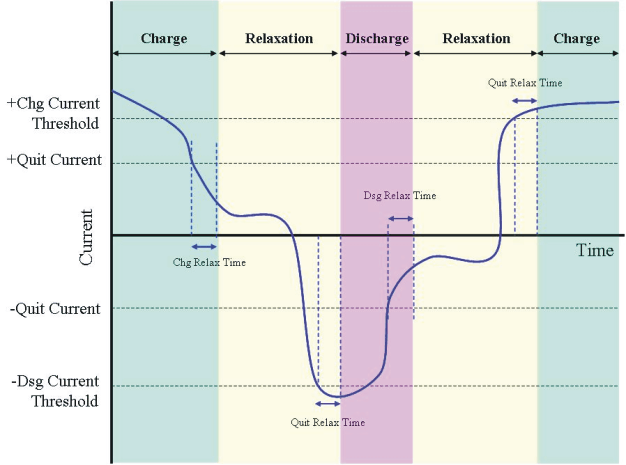SLUUCD5 January 2023 BQ27427
- Read This First
- 1General Description
- 2Functional Description
- 3Communications
- 4Application Examples
-
5Standard Commands
- 5.1
Control(): 0x00 and 0x01
- 5.1.1 CONTROL_STATUS: 0x0000
- 5.1.2 DEVICE_TYPE: 0x0001
- 5.1.3 FW_VERSION: 0x0002
- 5.1.4 DM_CODE: 0x0004
- 5.1.5 PREV_MACWRITE: 0x0007
- 5.1.6 CHEM_ID: 0x0008
- 5.1.7 BAT_INSERT: 0x000C
- 5.1.8 BAT_REMOVE: 0x000D
- 5.1.9 SET_CFGUPDATE: 0x0013
- 5.1.10 SMOOTH_SYNC: 0x0019
- 5.1.11 SHUTDOWN_ENABLE: 0x001B
- 5.1.12 SHUTDOWN: 0x001C
- 5.1.13 SEALED: 0x0020
- 5.1.14 PULSE_SOC_INT: 0x0023
- 5.1.15 CHEM_A:/B/C 0x0030/0x0031/0x0032
- 5.1.16 RESET: 0x0041
- 5.1.17 SOFT_RESET: 0x0042
- 5.2 Temperature(): 0x02 and 0x03
- 5.3 Voltage(): 0x04 and 0x05
- 5.4 Flags(): 0x06 and 0x07
- 5.5 NominalAvailableCapacity(): 0x08 and 0x09
- 5.6 FullAvailableCapacity(): 0x0A and 0x0B
- 5.7 RemainingCapacity(): 0x0C and 0x0D
- 5.8 FullChargeCapacity(): 0x0E and 0x0F
- 5.9 AverageCurrent(): 0x10 and 0x11
- 5.10 AveragePower(): 0x18 and 0x19
- 5.11 StateOfCharge(): 0x1C and 0x1D
- 5.12 InternalTemperature(): 0x1E and 0x1F
- 5.13 RemainingCapacityUnfiltered(): 0x28 and 0x29
- 5.14 RemainingCapacityFiltered(): 0x2A and 0x2B
- 5.15 FullChargeCapacityUnfiltered(): 0x2C and 0x2D
- 5.16 FullChargeCapacityFiltered(): 0x2E and 0x2F
- 5.17 StateOfChargeUnfiltered(): 0x30 and 0x31
- 5.1
Control(): 0x00 and 0x01
- 6Extended Data Commands
-
7Data Memory
- 7.1 Data Memory Interface
- 7.2 Data Types Summary
- 7.3 Data Flash Summary
- 7.4
Data Memory Parameter Descriptions
- 7.4.1 Configuration Class
- 7.4.2
Gas (Fuel) Gauging Class
- 7.4.2.1
IT Cfg Subclass
- 7.4.2.1.1 OCV Wait Time
- 7.4.2.1.2 Ra Filter
- 7.4.2.1.3 Resistance Update Voltage Drop
- 7.4.2.1.4 Samples to Wake
- 7.4.2.1.5 Qmax Max Time
- 7.4.2.1.6 Fast Qmax Start DOD%, Fast Qmax Start Voltage Delta, Fast Qmax Current Threshold
- 7.4.2.1.7 Fast Qmax End DOD%, Fast Qmax Minimum Data Points
- 7.4.2.1.8 Maximum Qmax Change
- 7.4.2.1.9 Qmax Maximum Delta %
- 7.4.2.1.10 Maximum % Default Qmax
- 7.4.2.1.11 Qmax Filter
- 7.4.2.1.12 Simulation ResRelax Time (ResRelax Time)
- 7.4.2.1.13 User-Defined Rate-Current
- 7.4.2.1.14 User-Defined Rate-Power
- 7.4.2.1.15 Maximum Simulation Rate, Minimum Simulation Rate
- 7.4.2.1.16 Ra Max Delta
- 7.4.2.1.17 Minimum Delta Voltage, Maximum Delta Voltage
- 7.4.2.1.18 DeltaV Maximum Delta Voltage
- 7.4.2.1.19 Terminate Voltage Valid Time
- 7.4.2.1.20 Trace Resistance
- 7.4.2.1.21 Downstream Resistance
- 7.4.2.1.22 Predict Ambient Time
- 7.4.2.1.23 Design Energy Scale
- 7.4.2.1.24 Fast Scale Load Select
- 7.4.2.1.25 Chg DOD Correction Start SOC
- 7.4.2.1.26 Chg DOD Correction Taper Ratio
- 7.4.2.2 Current Thresholds Subclass
- 7.4.2.3
State Subclass
- 7.4.2.3.1 Qmax Cell 0
- 7.4.2.3.2 Update Status
- 7.4.2.3.3 Reserve Capacity (mAh)
- 7.4.2.3.4 Load Select, Load Mode
- 7.4.2.3.5 Design Capacity, Design Energy, Default Design Capacity
- 7.4.2.3.6 Terminate Voltage
- 7.4.2.3.7 Thermal Rise Factor (T Rise)
- 7.4.2.3.8 Thermal Time Constant (T Time Constant)
- 7.4.2.3.9 SOC Interrupt Delta
- 7.4.2.3.10 Taper Rate, Taper Voltage
- 7.4.2.3.11 Sleep Current
- 7.4.2.3.12 Voltage at Charge Termination
- 7.4.2.3.13 Average Current Last Run
- 7.4.2.3.14 Average Power Last Run
- 7.4.2.3.15 Delta Voltage
- 7.4.2.1
IT Cfg Subclass
- 7.4.3 Ra Table Class
- 7.4.4 Chemistry Class
- 7.4.5 Calibration Class
- 7.4.6 Security Class
- 8Updating BQ27427 Configuration Parameters
- 9Revision History
7.4.2.2.1 Discharge and Charge Detection Threshold, Quit Current and Relax Time, Discharge and Charge Relax Time
| Subclass ID | Subclass | Offset | Type | Name | Value | Unit | ||
|---|---|---|---|---|---|---|---|---|
| Min | Max | Default | ||||||
| 81 | Current Thresholds | 0 | I2 | Dsg Current Threshold | 0 | 2000 | 167 | 0.1 h |
| 2 | I2 | Chg Current Threshold | 0 | 2000 | 100 | 0.1 h | ||
| 4 | I2 | Quit Current | 0 | 1000 | 250 | 0.1 h | ||
| 6 | U2 | Dsg Relax Time | 0 | 65535 | 60 | s | ||
| 8 | U1 | Chg Relax Time | 0 | 255 | 60 | s | ||
| 9 | U1 | Quit Relax Time | 0 | 255 | 1 | s | ||
The gauging algorithm transitions between three states: DISCHARGE, CHARGE, and RELAXATION modes of operation. During charge mode, the [DSG] bit of the Flags() register is cleared, and during discharge and RELAXATION mode it is set. Entry and exit for each mode is controlled by six parameters in the Current Thresholds Subclass.
The discharge current threshold can be calculated as Design Capacity/(Dsg Current Threshold × 0.1). The default is effectively C/16.7.
The charge current threshold can be calculated as Design Capacity/(Chg Current Threshold × 0.1). The default is effectively C/10.
The quit current threshold can be calculated as Design Capacity/(Quit Current × 0.1). The default is effectively C/25.
Charge mode is exited and RELAXATION mode is entered when EffectiveCurrent() goes below the quit current threshold for the number of seconds specified in Charge Relax Time (default 60 s). Discharge mode is entered when EffectiveCurrent() goes below the discharge current threshold for Quit Relax Time (default 1 s). Discharge mode is exited and RELAXATION mode is entered when EffectiveCurrent() goes above negative quit current threshold for Dsg Relax Time (default 60 s). Charge mode is entered when EffectiveCurrent() goes above the charge current threshold for Charge Relax Time (default 60 s).
 Figure 7-1 Example of Algorithm Operation Mode Changes with Varying DataRAM.Average Current()
Figure 7-1 Example of Algorithm Operation Mode Changes with Varying DataRAM.Average Current()